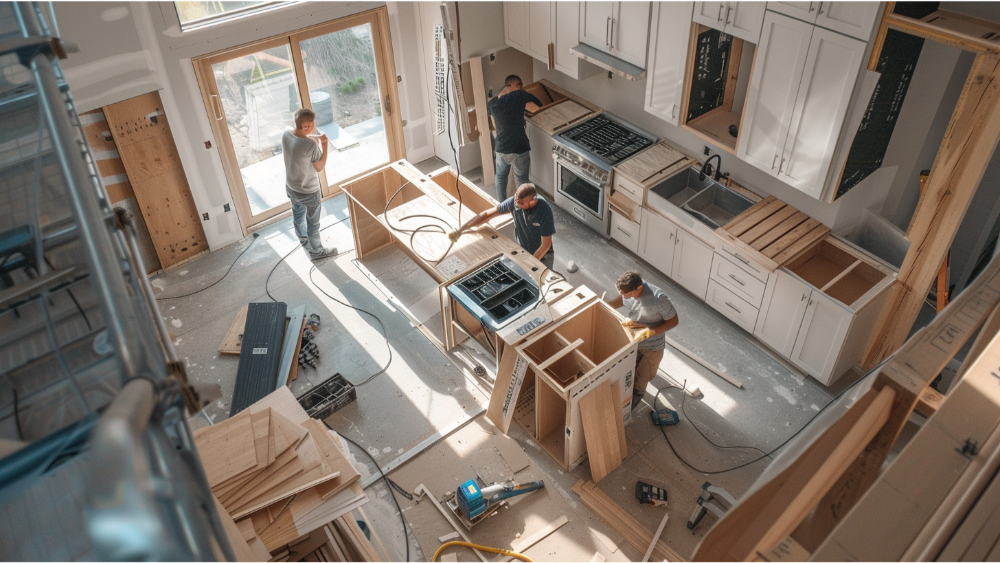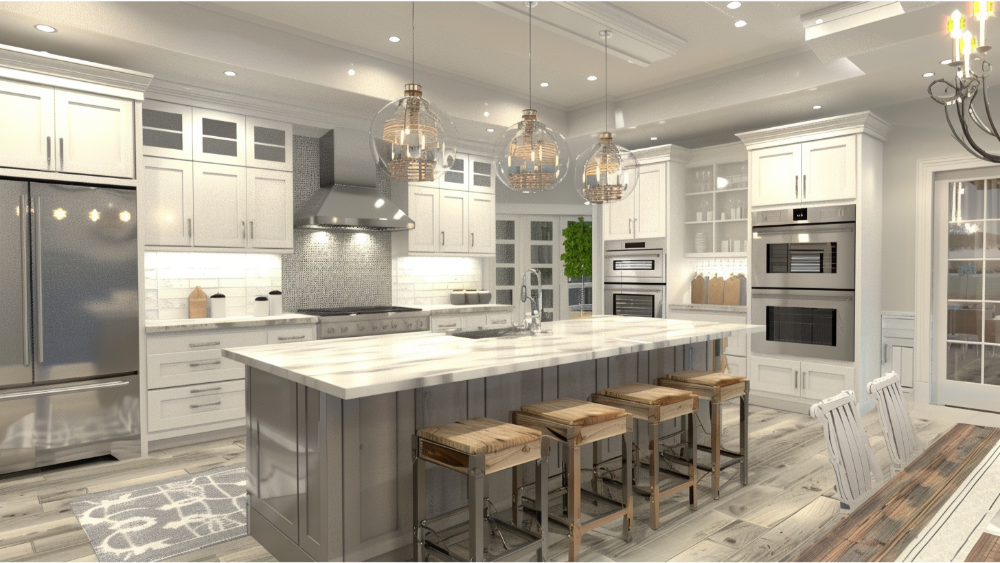How to Survive a Kitchen Remodel
Embarking on a kitchen remodel is both an exciting and daunting venture. Proper planning and realistic expectations can significantly alleviate the stress associated with this home improvement project. By preparing in advance and maintaining a flexible mindset, you can navigate through the challenges more smoothly and look forward to the rewarding outcome of a beautifully renovated kitchen. In this guide, we will share essential tips and strategies to help you survive your kitchen remodel with ease.
What You Should Expect During a Kitchen Remodel

Temporary Food Preparation Space
You’ll need to set up a temporary food preparation area, possibly in your dining room, another convenient location, or even the garage. This space should be equipped with basic cooking utensils, small appliances, and enough counter space to keep your meals manageable during the renovation period. Make sure the area is organized and easy to clean to maintain efficiency and hygiene.
Dust and Debris
Expect your home to be a bit dusty and messy. Kitchen renovations often involve demolishing old structures, leading to dust and debris throughout the remodeling area and potentially in adjoining rooms. Ensure to cover furniture and or seal off other areas to minimize the spread of dust and debris.
Noise
A kitchen remodel can be noisy, featuring constant hammering, drilling, and sawing. Prepare yourself for a significant amount of noise during work hours, which may be disruptive but is a normal part of the process. Consider planning activities away from home or setting up a quiet workspace away from the kitchen to minimize the impact. In the end, the result will be worth the temporary inconvenience!
Staying Organized
Staying organized during your kitchen renovation is crucial for maintaining sanity and efficiency. With a well-organized temporary kitchen setup, you can ensure that you have quick access to essential utensils and appliances, making meal preparation smoother and less stressful. Keep all items neatly arranged and easily retrievable to avoid unnecessary frustration. An organized approach helps you manage the chaos of the renovation process more effectively, allowing you to focus on the end goal of a beautifully transformed kitchen space.
Delays

Even with the best planning, unexpected delays can occur. Factors such as supply chain issues, unforeseen repairs, or contractor schedules may extend the project timeline. Maintaining flexibility will help you manage any setbacks. It’s also important to communicate regularly with all stakeholders and adjust expectations as needed to ensure everyone remains informed and on the same page.
Budget Adjustments
Keep in mind that mid-project budget adjustments are not uncommon. Additional expenses may arise due to unexpected findings during demolition or changes in material costs. Delays in shipping or unforeseen labor shortages can also impact the budget. Having a contingency fund is advisable to cover these potential extra costs and keep the project on track.
Stress
Undertaking a kitchen remodel can be stressful. The disruption to your regular routine and the decision-making involved can be overwhelming. It’s important to take breaks and practice patience throughout the remodel process. Remember to communicate clearly with your contractors and seek support from friends or family. The end result will be worth the effort!
Common Mistakes to Avoid When Remodeling a Kitchen

Lack of Proper Planning
Failing to develop a comprehensive plan before starting the remodel can lead to costly and time-consuming mistakes. To avoid these pitfalls, ensure you have a detailed layout, a clear budget, a timeline, and a list of necessary materials and appliances before beginning the project. Consider how you will manage daily life during the remodel. For instance, plan where you will store food and set up a makeshift kitchen to prepare meals while your main kitchen is under construction. Taking these extra steps will help ensure a smoother and more efficient remodeling process.
During the remodel, you might find it convenient to get takeout to avoid the hassle of cooking in a makeshift kitchen. Opt for healthier options such as a deli or a supermarket salad bar, which can provide nutritious and balanced meals without compromising on convenience. This approach will help maintain your well-being while navigating the temporary disruption in your home.
Ignoring Workflow and Functionality
A beautiful kitchen is important, but functionality is crucial. Avoid designing a kitchen that looks great but doesn’t cater to your cooking and preparation needs. To cook healthy meals and ensure a seamless cooking experience, pay close attention to the kitchen work triangle (the sink, stove, and refrigerator). This layout maximizes efficiency and ease of movement, making it easier to prepare nutritious dishes for you and your family.
Cutting Costs on Quality

It’s tempting to cut costs by opting for cheaper materials and contractors. However, this can lead to compromised quality and may result in having to redo parts of the remodel sooner than expected. Invest in high-quality materials and experienced professionals to ensure long-lasting results.
Consider the long-term value that quality work brings to your property. Higher standards not only improve durability but also enhance the overall aesthetic and resale value. It’s an investment that pays off in the long run, providing peace of mind and a better return.
Overlooking Storage Needs
Insufficient storage can turn your new kitchen into a cluttered space. Plan for ample storage solutions, including cabinets, drawers, and pantry space, to keep your kitchen organized and functional. Consider innovative storage options like pull-out shelves and deep drawers for better utilization of space. Make sure you have designated spots for all your appliances, which can include a coffee maker, toaster oven, slow cooker, and whatever else you may have. Utilize vertical storage and wall-mounted racks to free up counter space, and incorporate smart solutions like drawer dividers and lazy susans to keep everything easily accessible. Don’t forget to plan for the storage of bulk items and small gadgets, ensuring your kitchen remains a seamless and efficient workspace.
Health and Safety Tips for Your Kitchen

Proper Ventilation
Install a reliable range hood to significantly improve air quality by efficiently removing cooking fumes, smoke, and odors. Ensure your kitchen has adequate windows or an exhaust fan to allow for proper ventilation and fresh air circulation. This will create a healthier and more pleasant cooking environment.
Non-Slip Flooring
Choose flooring materials that are slip-resistant to prevent accidents, especially in areas prone to spills. Consider textured tiles or vinyl flooring with a non-slip surface.
Adequate Lighting
Incorporate a mix of ambient, task, and accent lighting to adequately illuminate work areas. Use under-cabinet lighting to reduce shadows on countertops and make food preparation safer.
Safe Appliance Placement
Position appliances such as microwaves and ovens at convenient heights to reduce the risk of burns and spills. Ensure that cords and outlets are safely installed and that appliances are placed away from water sources.
Child Safety
Install child-proof locks on lower cabinets to keep hazardous materials and sharp objects out of reach. Use stove knob covers and secure baby gates if needed to prevent young children from accessing the kitchen unsupervised.
Minimal Dish Usage
Using disposable dishes can greatly reduce the time and effort needed to wash dishes, allowing for a cleaner and safer environment. This will help save time and stress so you won’t have to wash dishes in an inconvenient place like the bathroom sink or laundry room.
Frequently Asked How to Survive a Kitchen Remodel Questions

How do you live when your kitchen is being remodeled?
Living through a kitchen remodel requires thoughtful planning and flexibility. Begin by setting up a temporary kitchen in another part of your home, using small appliances like a microwave, toaster oven, and electric kettle to prepare simple meals. Stock up on disposable plates, cups, and cutlery to minimize dishwashing, and consider pre-cooking meals that can be easily reheated.
Designate a storage space for your non-perishable food and essential cooking items to keep them organized and accessible. Plan to eat more meals out or order takeout to reduce the need for cooking. Communicate regularly with your contractors to stay informed about the timeline and to address any concerns promptly, ensuring a smoother and less stressful remodeling process.
What is the Hardest Part of a Kitchen Remodel?
The hardest part of a kitchen remodel is often dealing with the disruption to your daily life. Kitchens are central to the home, serving not just as a place for cooking and eating, but often as a communal space for family and friends to gather. When your kitchen is out of commission, finding suitable alternatives for meal preparation and maintaining a semblance of normalcy becomes a significant challenge.
The constant noise, dust, and comings and goings of contractors can also be stressful and intrusive. Managing unexpected issues such as hidden structural problems or delays in materials can test your patience and potentially extend the length of the project. Effective planning, patience, and flexibility are essential to navigate these hurdles and keep stress levels manageable.
What is the Most Expensive Part of Remodeling Your Kitchen?
The most expensive part of remodeling your kitchen is typically the Kitchen cabinetry. High-quality cabinets can constitute a significant portion of your budget due to the cost of materials, craftsmanship, and customization. Custom cabinets, designed to fit your specific kitchen layout and preferences, tend to be more costly than standard, pre-manufactured options.
Factors such as the type of wood, finishes, and hardware selected can greatly influence the final price. While it might be tempting to cut corners, investing in durable and well-designed cabinetry can result in enhanced functionality and aesthetic appeal, ultimately adding more value to your home.
Conclusion

Surviving a kitchen remodel requires strategic preparation, flexibility, and a positive mindset. By planning for temporary kitchen arrangements, prioritizing health and safety, investing wisely in essential kitchen features, and opting for a swift high-performing contractor such as America’s Advantage Remodeling, you can minimize disruptions and stress. Remember, though the process may be challenging, the reward of a beautifully remodeled kitchen tailored to your needs and preferences is well worth the effort. Keep communication open with your contractors, stay informed, and embrace the journey towards creating a more functional and appealing heart of your home.
